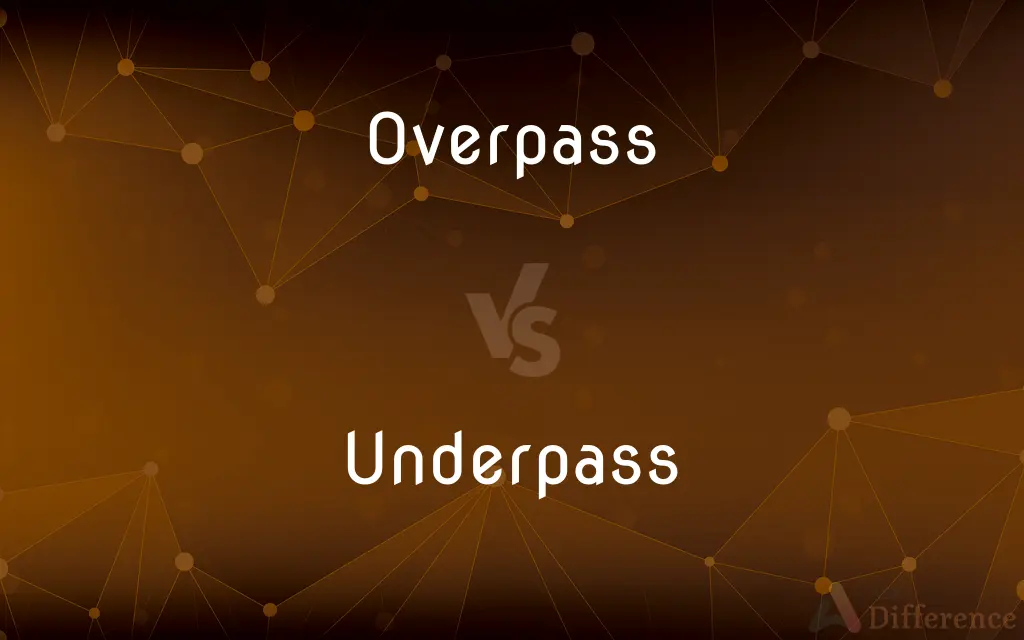Overpass vs. Underpass — What's the Difference?
By Tayyaba Rehman — Updated on October 20, 2023
Overpass is a bridge allowing one road or railway to cross over another. Underpass is a tunnel allowing one road or railway to pass under another.

Difference Between Overpass and Underpass
Table of Contents
ADVERTISEMENT
Key Differences
Overpass and Underpass are both structures designed to allow for efficient and unobstructed movement of transportation. An Overpass is a structure that elevates one roadway or track above another. On the other hand, an Underpass allows one roadway or track to travel beneath another.
Both Overpass and Underpass aim to eliminate intersections and reduce traffic congestion. The Overpass elevates, making it visible and easy to identify as drivers or pedestrians approach it. Conversely, the Underpass typically takes the form of a tunnel or a lowered road that goes beneath an obstacle.
Choosing between constructing an Overpass or an Underpass depends on numerous factors including land topology, cost, and environmental considerations. An Overpass might be preferred when there's a need to elevate a roadway above a busy intersection or natural barrier. In contrast, an Underpass might be more suitable if there's limited vertical space or to maintain scenic views.
Safety and maintenance also play roles in the decision between an Overpass and Underpass. Overpasses may require safety barriers, anti-icing systems, and frequent inspections for structural integrity. Underpasses, on the other hand, might need drainage systems, lighting, and ventilation if they are long.
Regardless of their differences, both Overpasses and Underpasses contribute significantly to the efficiency of transportation networks, providing smoother, faster, and safer routes for vehicles and pedestrians.
ADVERTISEMENT
Comparison Chart
Structural Form
Elevated bridge or structure
Tunnel or lowered road
Visibility
Visible as it elevates above surroundings
Often concealed or goes beneath another structure
Typical Use
Cross above roads, railways, or waterways
Pass beneath roads, railways, or obstacles
Maintenance Needs
Safety barriers, anti-icing systems
Drainage systems, lighting, ventilation
Environmental
May obstruct views, casts shadows
Preserves views, might require land excavation
Compare with Definitions
Overpass
A raised bridge or structure.
The Overpass allowed cars to cross the river without a ferry.
Underpass
A route below ground level.
The Underpass was dimly lit, making it feel a bit eerie at night.
Overpass
A structure preventing intersections.
Building an Overpass helped reduce traffic jams at the junction.
Underpass
A roadway or path that goes below another.
The animal Underpass was built to protect wildlife from busy traffic.
Overpass
A route above ground level.
The pedestrian Overpass provides safe crossing over the busy street.
Underpass
A tunnel or passage beneath a road or railway.
She took the Underpass to avoid the rain while walking to the station.
Overpass
An overpass (called an overbridge or flyover in the United Kingdom and some other Commonwealth countries) is a bridge, road, railway or similar structure that crosses over another road or railway. An overpass and underpass together form a grade separation.
Underpass
A structure allowing traffic to pass underneath.
The highway Underpass eased congestion at the main intersection.
Overpass
A passage, roadway, or bridge that crosses above another roadway or thoroughfare.
Underpass
A road or pedestrian tunnel passing under a road or railway.
Overpass
To pass over or across; traverse.
Underpass
A passage underneath something, especially a section of road that passes under another road or a railroad.
Overpass
To go beyond; surpass.
Underpass
An intersection formed in this way.
Overpass
To go over (a limit or boundary); transgress.
Underpass
A passage that crosses a road, railroad or similar obstacle in a tunnel underneath it.
Overpass
To overlook or disregard.
Underpass
An underground tunnel or passage enabling pedestrians to cross a road or railway
Overpass
A section of a road or path that crosses over an obstacle, especially another road, railway, etc.
The homeless man had built a little shelter, complete with cook-stove, beneath a concrete overpass.
Underpass
An infrastructure preventing direct intersections.
The new Underpass helped in the seamless flow of vehicles without stoppages.
Overpass
To pass above something, as when flying or moving on a higher road.
Gillian watched the overpassing shoppers on the second floor of the mall, as she relaxed in the bench on the ground floor.
Overpass
(transitive) To exceed, overstep, or transcend a limit, threshold, or goal.
Marshall was really overpassing his authority when he ordered the security guards to fire their tasers at the trespassers.
The precocious student had really overpassed her peers, and was reading books written for children several years older.
Overpass
(transitive) To disregard, skip, or miss something.
“Don’t overpass those cheeses; they’re really quite excellent!” gushed Terry, pointing to the buffet table.
Overpass
To go over or beyond; to cross; as, to overpass a river; to overpass limits.
Overpass
To pass above; - of roadways and other paths; as, the highway overpasses the railroad tracks.
Overpass
To pass over; to omit; to overlook; to disregard.
All the beauties of the EastHe slightly viewed and slightly overpassed.
Overpass
To surpass; to excel.
Overpass
To pass over, away, or off.
Overpass
A road or other pathway which passes over another road, railroad, or other path; as, he stopped on the street under the railroad overpass.
Overpass
Bridge formed by the upper level of a crossing of two highways at different levels;
An overpass is called a flyover or a flypast in England
Overpass
An elevation of one transportation route over another.
The train travels on the Overpass above the highway.
Overpass
A roadway higher than its surrounding area.
The city constructed an Overpass to connect the two neighborhoods.
Common Curiosities
What is an Overpass?
An Overpass is a raised structure allowing one road or railway to cross over another.
What's the main advantage of an Underpass?
Underpasses offer a seamless way for traffic to continue without stopping for intersections, and they can preserve scenic views.
Do Underpasses pose any safety concerns?
Yes, Underpasses may require adequate lighting, ventilation, and regular maintenance to ensure safety.
Which is more expensive to construct, an Overpass or an Underpass?
The cost varies based on location, design, and environmental factors. Sometimes an Overpass may be cheaper, while in other cases, an Underpass might be more cost-effective.
Are Underpasses primarily for urban areas?
While Underpasses are common in urban areas to manage traffic, they're also found in rural regions, often for wildlife crossings or to navigate natural barriers.
How long does it typically take to construct an Overpass?
The duration varies based on the size, complexity, and other factors, but construction can range from a few months to several years.
Do Overpasses have weight limits?
Yes, based on their design and materials, Overpasses may have specified weight limits for safety.
What is an Underpass?
An Underpass is a tunnel or passage that allows a road or railway to pass underneath another.
Are Overpasses always for vehicles?
No, Overpasses can also be pedestrian bridges, allowing people to walk over busy roads or railways.
Why are Overpasses built?
Overpasses are built to alleviate traffic congestion by allowing vehicles or trains to pass over intersections or obstacles without interruption.
Can Underpasses lead to flooding issues?
Yes, if not designed with adequate drainage, Underpasses can accumulate water and lead to flooding.
Which has a greater visual impact on the landscape, an Overpass or an Underpass?
An Overpass generally has a more prominent visual impact since it rises above the surroundings, while an Underpass is often concealed.
Can an Overpass and Underpass be present at the same location?
Yes, it's possible, especially in complex transportation networks or multi-level intersections.
What materials are typically used to build an Overpass?
Common materials include concrete, steel, and sometimes a combination of both.
Can both Overpasses and Underpasses be used for pedestrian traffic?
Yes, both can be designed specifically for pedestrian use to ensure safe crossings over or beneath busy routes.
Share Your Discovery

Previous Comparison
Rock vs. Pop
Next Comparison
Molarity vs. MolalityAuthor Spotlight
Written by
Tayyaba RehmanTayyaba Rehman is a distinguished writer, currently serving as a primary contributor to askdifference.com. As a researcher in semantics and etymology, Tayyaba's passion for the complexity of languages and their distinctions has found a perfect home on the platform. Tayyaba delves into the intricacies of language, distinguishing between commonly confused words and phrases, thereby providing clarity for readers worldwide.
















































